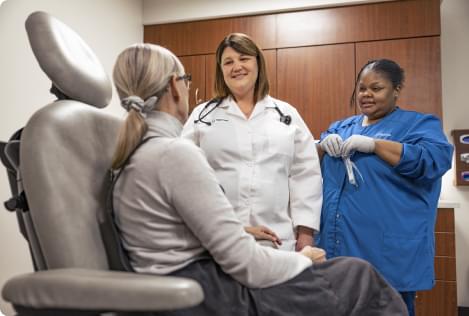Overview
Congenital diaphragmatic hernia (CDH) is a rare condition that happens in a baby before birth. It occurs early in pregnancy when a baby's diaphragm — the muscle that separates the chest from the abdomen — fails to close as it should. This leaves a hole in the diaphragm. The hole is called a hernia.
This hernia in the muscle of the diaphragm creates an opening between the abdomen and the chest. The intestines, stomach, liver and other abdominal organs may move through the hole into the baby's chest. If the intestines are in the chest, they don't develop the typical connections that hold them in place in the abdomen (malrotation). They may twist on themselves, cutting off their blood supply (volvulus).
In addition, the lung is small on the side of the diaphragm with the hernia, but the development of both lungs is affected. The air sacs (alveoli) inside the lungs don't develop as they should. This results in problems with blood flow and increased pressure inside the lung's blood vessels. The blood pressure in the lungs is higher than it should be, which can make it hard for the baby to breathe after birth. Some infants may also have problems with heart development.
Treatment of CDH depends on when the condition is found, how serious it is and whether there are problems with the heart.
Symptoms
Congenital diaphragmatic hernia ranges in severity. It may be mild and have few or no effects on the baby, or it can be more serious and affect the ability to bring oxygen to the rest of the body.
Babies born with CDH may have:
- Severe trouble breathing due to small lungs that don't work well (pulmonary hypoplasia).
- A type of high blood pressure that affects the arteries in the lungs and the right side of the heart (pulmonary hypertension).
- Problems with development of the heart.
- Damage to the intestines, stomach, liver and other abdominal organs if they move through the hernia into the chest.
When to see a doctor
CDH may be found during a routine fetal ultrasound. Your health care provider can discuss treatment options with you.
Causes
In most cases, the cause of congenital diaphragmatic hernia is not known. In some cases, CDH can be linked to a genetic disorder or random gene changes called mutations. In these cases, the baby may have more issues at birth, such as problems with the heart, eyes, arms and legs, or stomach and intestines.
Complications
Complications that can occur with CDH include:
- Lung problems.
- Stomach, intestine and liver problems.
- Heart disease.
- Recurrent infections.
- Hearing loss.
- Changes in the shape of the chest and curve of the spine.
- Gastroesophageal reflux — stomach acid flowing back into the tube called the esophagus, which connects the mouth and stomach.
- Problems with growth and weight gain.
- Developmental delays and learning disabilities.
- Other problems present from birth.
Diagnosis
Congenital diaphragmatic hernia is most often found during a routine fetal ultrasound exam that's done before your baby is born. A prenatal ultrasound exam uses sound waves to make images of your uterus and baby.
Occasionally, the diagnosis may not be made until after birth. Rarely, CDH may not be diagnosed until childhood or later. This may be because there are no signs or symptoms or because signs and symptoms such as respiratory and intestinal problems are mild.
Your health care provider uses prenatal ultrasound and other tests to track the growth and function of your baby's lungs, heart and other organs during your pregnancy.
Prenatal ultrasound
Usually, you have your first fetal ultrasound during the first few months (first trimester) of your pregnancy. It confirms that you are pregnant and shows the number and size of your baby or babies.
Most often, you have another ultrasound during months four to six (second trimester) of your pregnancy. Your health care provider checks the growth and development of your baby. Your provider looks at the size and location of your baby's lungs, heart and other organs.
If your baby shows signs of CDH, your provider may have you get ultrasound exams more often. This can show how severe CDH is and whether it's getting worse.
Other tests
More tests may be done to assess the function of your baby's organs. These may include:
- Fetal magnetic resonance imaging (MRI). This is a medical imaging technique that uses a magnetic field and computer-generated radio waves to create detailed images of the organs and tissues in the baby's body.
- Fetal echocardiogram. An echocardiogram uses sound waves to produce images of the baby's heart beating and pumping blood. The images from an echocardiogram can identify problems with the developing heart.
- Genetic tests. Genetic testing can identify genetic syndromes or other gene changes that are sometimes associated with CDH. Genetic counseling can help you understand these test results and give you more information about your baby's condition.
Treatment
Treatment of congenital diaphragmatic hernia depends on when the condition is found and how serious it is. Your health care team helps you decide what's best for you and your baby.
Care before delivery
Your health care team watches you closely before your baby is born. You typically have ultrasounds and other tests often to check your baby's health and development.
An emerging treatment for severe CDH now being studied is called fetoscopic endoluminal tracheal occlusion (FETO). This surgery is done on your baby while you're still pregnant. The goal is to help the baby's lungs grow as much as possible before birth.
FETO is done in two procedures:
First procedure. The first procedure happens early in the last few months (third trimester) of your pregnancy. Your surgeon makes a small incision in your abdomen and uterus. The surgeon inserts a special tube with a camera at the end, called a fetal endoscope, through your baby's mouth and into the windpipe (trachea). A small balloon is placed in your baby's trachea and inflated.
The natural uterine fluid during pregnancy, called amniotic fluid, flows in and out of your baby's lungs through the mouth. Inflating the balloon keeps amniotic fluid in your baby's lungs. The fluid expands the lungs to help them develop.
Second procedure. After about 4 to 6 weeks, you have a second procedure. The balloon is removed so that your baby is ready to take air into the lungs after birth.
A special delivery method may be used if labor starts before the balloon has been removed and removal of the balloon with an endoscope is not possible. This method is called an ex utero intrapartum treatment (EXIT) procedure. The delivery is done by C-section with placental support. This means that your baby continues to get oxygen through the placenta before the umbilical cord is cut. Placental support continues until the balloon is out and a breathing tube is in place, allowing a machine to take over breathing.
FETO may not be the right choice for everyone. And there's no guarantee about the results of surgery. Your health care team evaluates you and your baby to see whether you may be candidates for this surgery. Talk to your team about the benefits and possible complications for you and your baby.
Care during delivery
Usually, you can deliver your baby either vaginally or by C-section. You and your health care provider decide which method is best for you.
Care after delivery
After birth, the health care team helps you plan treatment that meets your baby's needs. Your baby will likely be cared for in the newborn intensive care unit (NICU).
Your baby may need to have a breathing tube. The tube is attached to a machine that helps your baby breathe. This gives the lungs and heart time to grow and develop.
Babies who have life-threatening lung problems may need a treatment called extracorporeal membrane oxygenation (ECMO). This is also known as extracorporal life support (ECLS). The ECMO machine does the work of your baby's heart and lungs, allowing these organs to rest and heal.
How long your baby needs support to breathe depends on the response to treatment and other factors.
Most babies who have CDH have surgery to close the hole in the diaphragm. When this surgery takes place depends on your baby's health and other factors. Follow-up care to ensure the repair remains in place usually includes chest X-rays.
After leaving the hospital, your baby may need extra support. This can include supplemental oxygen. Oxygen is delivered by thin plastic tubing with prongs that fit into the nostrils or thin tubing connected to a mask worn over the nose and mouth. Feeding support may also be needed to help with growth and development. Medicine may be given for conditions associated with CDH, such as acid reflux or pulmonary hypertension.
Regular follow-up appointments with your child's health care provider can address any problems early.
Coping and support
Learning that your baby has congenital diaphragmatic hernia can bring a range of emotions. You may have many questions about the treatment plan for you and your baby.
You don't have to face this alone. There are many resources to support you and your baby. If you have questions about your baby's condition and treatment, talk with your health care team.
Preparing for an appointment
You'll probably start by discussing your baby's condition with your obstetrician. You'll likely be referred to a health care team with experience in caring for congenital diaphragmatic hernia.
What you can do
To prepare for your appointment:
- Ask a family member or friend to come with you, if you're comfortable with that. Sometimes it can be difficult to remember all the information provided during an appointment. Someone who goes with you may remember something that you missed or forgot. You may want to take notes.
- Prepare questions to ask your health care provider, so you don't forget to cover anything that's important to you.
Some basic questions to ask include:
- What's the likely cause of my baby's condition?
- How severe is the condition?
- What other problems might my baby have with CDH?
- What tests will my baby need?
- What treatments are available, and what do you recommend?
- What are the chances of having another baby with this condition?
- Should I see a specialist?
- Are there brochures or other printed materials that I can have? What websites do you recommend?
© 1998-2024 Mayo Foundation for Medical Education and Research (MFMER). All rights reserved. Terms of Use


